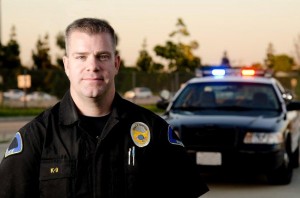There are many dangers associated with being a law enforcement officer. Many come simply from driving. The police have to protect the public but also protect themselves by not taking risks while in or around their vehicle. Here is a roundup of eight ways for police officers to keep safe on the job.
1. Don’t drive tired: It’s been proven that driving fatigued can be as bad as driving drunk. You’re especially at risk if you work overnight; the darkness can make anyone want to doze. Recognize the warning signs and know when you need to take a break: eyes closing or going out of focus, persistent yawning, irritability and wandering thoughts, among others.
2. Wear a seatbelt: This should go without saying, but it doesn’t. Not only is it a good example for the public, it is a no-brainer for keeping officers safe on the roadways. Sadly, almost half of officers killed in vehicle accidents were not wearing a seatbelt.
3. Use GPS: 911 dispatchers can use GPS to see where officers’ vehicles are at all times. Not only does it allow for the monitoring of safe driving habits, a live map shows the dispatcher which officer is nearest to the scene of an emergency. GPS speeds up the decision-making process, saving what can be critical moments, and the operator can send an officer who can get to the incident the soonest. As always, be sure officers are trained on any new technology in the vehicle, such as GPS-enabled laptops.
4. Avoid multitasking: Police officers today are outfitted with all kinds of equipment in their vehicles, including cameras and computers. Use extreme caution if you have to use this technology while behind the wheel. Eating, drinking or having a conversation while driving can be distracting, too. If it’s not an emergency situation, stop the car and do what you need to do.
5. Wear a reflective vest: Increasing your visibility is a simple but crucial step to take when you exit your vehicle to enter the roadway or stand on the shoulder. If the situation allows, pick these locations wisely — try not to pull over on a blind curve, where other drivers have little or no chance to see you in time to slow down.
6. Keep tires maintained: The vehicle should have a light that warns the driver when tire pressure is low, but it doesn’t hurt to check it once in a while, especially when the temperature drops significantly at the beginning of winter. Check tire treads using the “penny test”: place an upside-down penny in one of the treads. If you can see the top of Lincoln’s head, your treads are wearing down and the tire should be replaced.
7. Don’t speed unless necessary: Speed can kill. The faster a car is moving, the less time the driver has to react to any obstacle. Making sudden maneuvers at high speeds leads to accidents.
8. Call for backup: If you have a feeling that backup is needed, ask for it. Don’t worry about inconveniencing other officers. You are better safe than sorry if you suspect that someone has a gun or that you will be in a threatening situation.
Author Bio:
Cheryl Bikowski is Marketing Communications Supervisor of Gamber-Johnson in Stevens Point, WI. Gamber-Johnson is a leading supplier of vehicle computer mounts and vehicle docking stations and is a member of the Leggett & Platt Commercial Vehicle Products (CVP) Group.
- California Casualty Earns Financial Stability Rating® of A, Exceptional, From Demotech, Inc. - April 28, 2025
- Music & Arts Grant Recipients – 2024 - December 13, 2024
- Understanding Auto and Home Insurance Rate Changes - December 3, 2024

